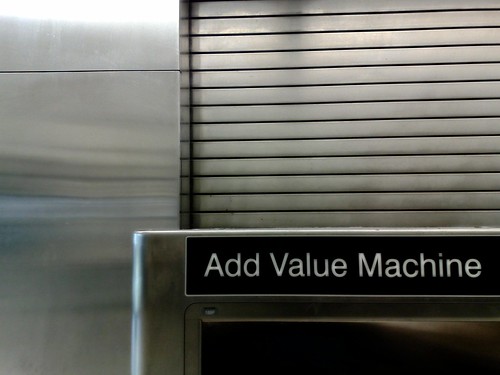Around the time we added support for Open Plaques machine tags Frankie Roberto, the project lead, asked: “What about supporting Open Street Map (OSM) way machine tags?”
My immediate response was something along the lines of “That’s maybe a bit too dorky, even for us.” Which meant that I kept thinking about it. And now we’re doing it.
If you’re not sure way what a “way” is, it’s best to start with OpenStreetMap’s own description of how their metadata is structured:
Our maps are made up of only a few simple elements, namely nodes, ways and relations. Each element may have an arbitrary number of properties (a.k.a. Tags) which are Key-Value pairs (e.g. highway=primary) …
A node is the basic element of the OSM scheme. Nodes consist of latitude and longitude (a single geospacial point) …
A way is an ordered interconnection of at least 2 and at most 2000 nodes that describe a linear feature such as a street, or similar. Should you reach the node limit simply split your way and group all ways in a relation if necessary. Nodes can be members of multiple ways.
Frankie’s interest is principally in marking up buildings in and around Manchester, where he lives. When he tags one of his photos with osm:way=30089216 we can fetch the metadata (the key-value pairs) for that way using the OSM API and see that it has the following properties:
<osm version="0.6" generator="OpenStreetMap server"> <way id="30089216" visible="true" timestamp="2009-07-04T12:02:47Z" version="2" changeset="1728727" user="Frankie Roberto" uid="515"> <nd ref="331415447"/> <nd ref="331415448"/> <nd ref="331415449"/> <nd ref="331415450"/> <nd ref="331415447"/> <tag k="architect" v="Woodhouse, Corbett & Dean"/> <tag k="building" v="yes"/> <tag k="created_by" v="Potlatch 0.10f"/> <tag k="name" v="St George's House"/> <tag k="old_name" v="YMCA"/> <tag k="start_date" v="1911"/> </way> </osm>
That allows to us “expand” the original machine tag and display a short caption next to the photo, in this case: “St George’s House is a building in OpenStreetMap” with a link back to the web page for that way on the OSM site.
The technical terms for this process is “Adding the machine tags extra love“.
You may have noticed that there are a bunch of other key-value pairs in that example, like the name of the architect, that we don’t do anything with. Which attributes are we looking for, then? The short answer is: Not most of them. The complete list of map features in OSM is a bit daunting in scope and constantly changing. It would be nice to imagine that we could keep pace with the discussions and the churn but that’s just not going to happen. If nothing else, the translations alone would become unmanageable.
Instead we’re going to start small and see where it takes us. Here are the list of tagged features in a way or node definition that we pay attention to, and how they’ll be displayed:
-
k=name v={NAME}
… is a feature in OpenStreetMap (If present, with another recognized tag we will display the name for the thing being described in place of the more generic “this is a…”) -
k=building v=yes
… is a building in OpenStreetMap -
k=historic
… is an historic site in OpenStreetMap -
k=cycleway
… is a bicycle path in OpenStreetMap -
k=motorway (v=cycleway)
… is a highway in OpenStreetMap (unless v is “cycleway” in which case it’s a bike path) -
k=railway v=subway (or tram or monorail or light_rail)
… is a subway (or tram or monorail or light_rail) line in OpenStreetMap -
k=railway v=station
… is a train station in OpenStreetMap; if the type of railway is also defined (above) then we’ll be specific about the type of station. I should mention that as of this writing we’re still waiting for the translations for “this is a train station” to come back because I, uh… anyway, real soon now. -
k=waterway v=stream (or canal or river)
… this is a stream (or canal or river) in OpenStreetMap -
k=landuse v=farm (or forest)
… this is a farm (or forest) in OpenStreetMap -
k=natural v=forest (or beach)
… this is a forest (or beach) in OpenStreetMap
Which means: We’ve almost certainly got at least some of it wrong. Anyone familiar with OSM features will probably be wondering why we haven’t included amentiy or shop tags since they contain a wealth of useful information. I hope we will, but it wasn’t clear how we should decide which features to support (more importantly, which to exclude) and the number of possible combinations were starting to get a bit out of hand and we have this little photo-sharing site to keep running.
This is the part where I casually mention that we’ve also added machine tags extra love for Four Square venues IDs. I’m just saying…
The features we’re starting with may seem a bit odd, with a heavy focus on natural land features (and train stations). Some of this is a by-product of the work we’ve been pursuing with the alpha shapes and “donut holes”, derived from geotagged photos, and some of it is just trying to shine the spotlight on places and environments that we take for granted.
Like I said, we’ve almost certainly got at least some of it wrong but hopefully we got part of it right and can correct the rest as we go. This one is definitely a bit more of an experiment than some of the others.
Finally, in the tangentially related department we finished wiring up the RSS/syndication feeds to work properly with wildcard machine tags. That means you can subscribe to a feed of all the (public) photos tagged with osm:way= or osm:node= or, if you’re like me, all the photos of places to eat in Dopplr with dopplr:eat=.
Enjoy!
















